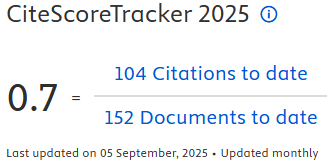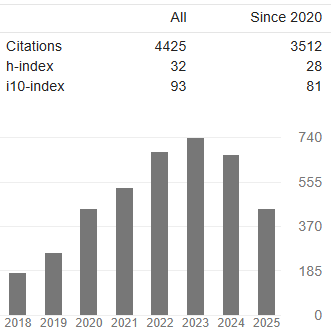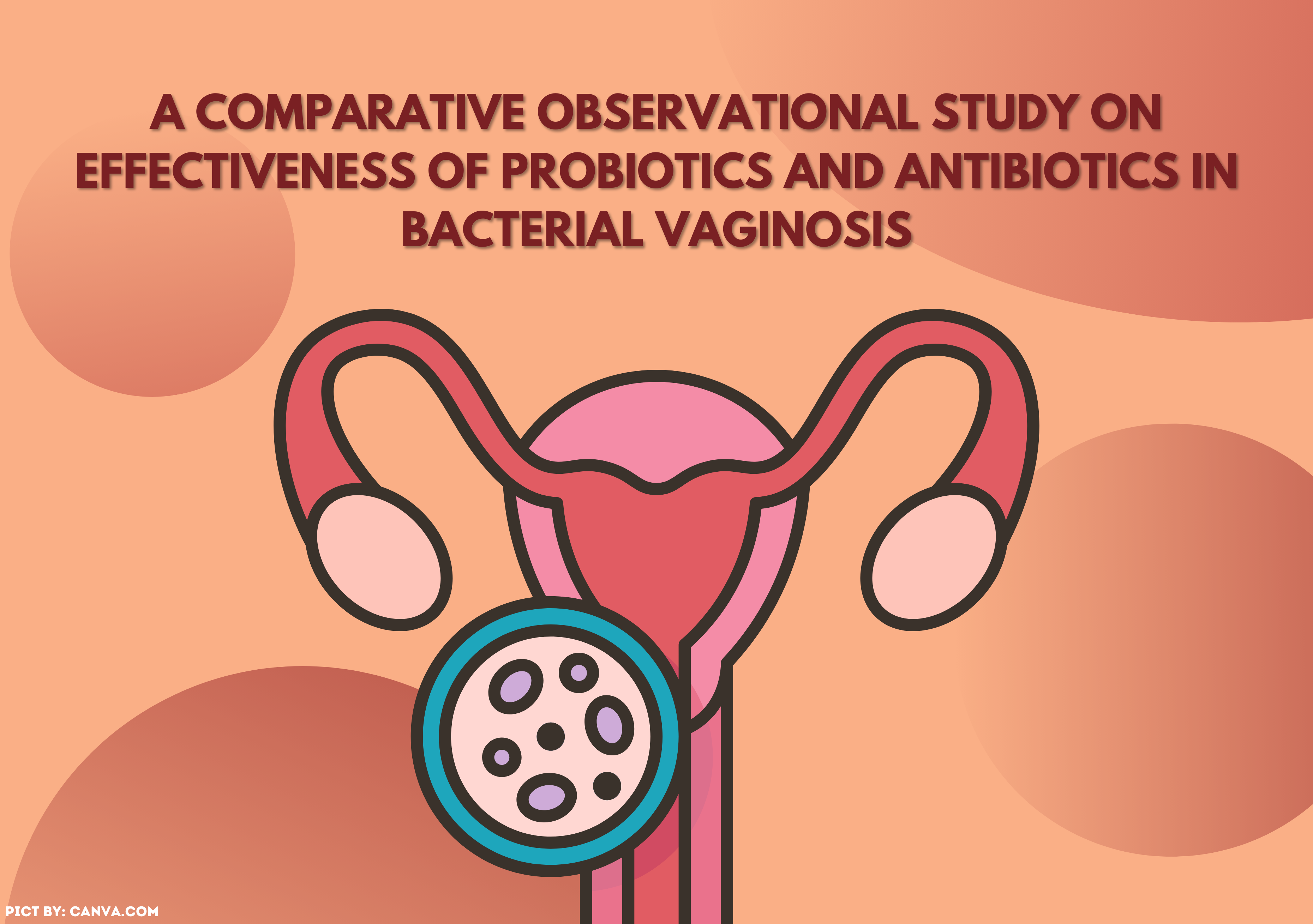THE RELATIONSHIP BETWEEN WORKING BEHAVIOR AND THE INCIDENCE OF TYPE II DIABETES MELLITUS OF WORKERS WITH THE SNEHANDU THEORY
Downloads
ABSTRACT
There are two types of Diabetes Mellitus (DM), namely Type I DM and Type II DM. Type II DM is caused by the inability of the body to respond to insulin that is produced by the pancreas, thus resulting in an increase in blood glucose levels. Eleven out of twenty workers at the Faculty of Public Health, Universitas Airlangga suffered from Type II DM. Observational research with a quantitative approach was conducted through a cross-sectional approach. The population selected was 89 workers at the faculty. The samples were randomly selected with the characteristics of having more than 45 years of age. There were significant variables between working behavior and the incidence of Type II DM including work, last education, and social support. Furthermore, there were insignificant variables between working behavior and the incidence of Type II DM including gender, age, family members, frequency of exercise, behavior intention, personal autonomy, accessibility to information, and action situation. In conclusion, individual's latest education, employment, and social support had a significant relationship with exercise behavior and the incidence of Type II DM.
Keywords: physical exercise, diabetes mellitus, wokers at FKM Universitas Airlangga
Achmad Yoga Setyo Utomo, Hari Peni Julianti, D. P. (2011) ‘Hubungan Antara 4 Pilar Pengelolaan Diabetes Melitus dengan Keberhasilan Pengelolaan Diabetes Melitus Tipe 2.', Artikel Karya Ilmiah.
Ajzen, I. (2005) ‘Attitudes, Personality and Behaviour', in Mapping Social Psychology, pp. 1–178. doi: 10.1037/e418632008-001.
Akoit, E. E. (2015) ‘Dukungan Sosial Dan Perilaku Perawatan Diri Penyandang Diabetes Melitus Tipe 2', Keperawatan, 14(2), pp. 952–966.
Alghadir, A. et al. (2014) ‘Diabetes risk 10 years forecast in the capital of Saudi Arabia: Canadian diabetes risk assessment questionnaire (CANRISK) perspective', Biomedical Research (India).
Association, A. D. (2014) ‘Diagnosis and Classiï¬cation of Diabetes Mellitus', Diabetes Care, 37(1), pp. 581–590. doi: 10.2337/dc14-S081.
Cabral, E. D. D., Tahu, S. K. and Tage, P. K. (2016) ‘Modus Adaptasi Pasien Diabetes Mellitus Terhadap Penyakit Yang Di Derita Dengan Pendekatan Konsep Model Sisiter Calista Roy', CHM-K Health Journal.
Damayanti, S. (2015) ‘Senam Diabetes Mellitus Dengan Kadar Gula Darah, Kadar Kolesterol Dan Tekanan Darah Pada Klien Diabetes Mellitus Tipe 2 Di ...', Medika.Respati.Ac.Id, 10(April).
Dasar, R. K. (2013) ‘Badan Penelitian dan Pengembangan Kesehatan', Laporan Nasional 2013, pp. 1–384. doi: 1 Desember 2013.
Dewi, R. (2013) ‘Faktor Risiko Perilaku yang Berhubungan dengan Kadar Gula Darah pada Penderita Diabetes Melitus Tipe 2 di RSUD Kabupaten Karanganyar', Jurnal Kesehatan Masyarakat, 2(1), pp. 118–128..
Essy Phitri, H. et al. (2013) ‘Hubungan Antara Pengetahuan Dan Sikap Penderita Diabetes Mellitus Dengan Kepatuhan Diet Diabetes Mellitus Di Rsud Am. Parikesit Kalimantan Timur', Mei, 1(1), pp. 58–74.
Evans, M. et al. (2013) ‘Health-related quality of life associated with daytime and nocturnal hypoglycaemic events: A time trade-off survey in five countries', Health and Quality of Life Outcomes. doi: 10.1186/1477-7525-11-90.
Fauzia, Y., Sari, E. and Artini, Bu. (2013) ‘Gambaran Faktor-Faktor Yang Mempengaruhi Kepatuhan Diet Penderita Diabetes Mellitus Di Wilayah Puskesmas Pakis Surabaya', Keperawatan, 4(2).
Grant, J. F. et al. (2009) ‘Gender-specific epidemiology of diabetes: A representative cross-sectional study', International Journal for Equity in Health, 8. doi: 10.1186/1475-9276-8-6.
Hagger, M. S. et al. (2013) ‘Chronic Inhibition, Self-Control and Eating Behavior: Test of a "Resource Depletion” Model', PLoS ONE, 8(10). doi: 10.1371/journal.pone.0076888.
Handayani, O. and Tandra, H. (2010) ‘Pattern of type 2 diabetes mellitus in Surabaya, Indonesia', Endocrine abstracts, 22, p. 308.
Haskas, Y. (2018) ‘Variabilitas locus of control pada pasien diabetes mellitus tipe II', Variabilitas Locus of Control Pada Pasien Diabetes Mellitus Tipe Ii, 12(locus of control), pp. 358–361.
Herdianti, H. (2017) ‘Determinan Kualitas Hidup Penderita Dm Tipe 2 Di Rsud Ajjappange', Jurnal Endurance, 2(1), p. 74. doi: 10.22216/jen.v2i1.1662.
Iglay, H. B. et al. (2007) ‘Resistance training and dietary protein: Effects on glucose tolerance and contents of skeletal muscle insulin signaling proteins in older persons', American Journal of Clinical Nutrition, 85(4), pp. 1005–1013.
International Federation of Diabetes (IDF) (2017) ‘Diabetes atlas', International Diabetes Federation., 8th edn., pp. 1–150. doi: http://dx.doi. org/10.1016/S0140-6736(16)31679-8.
Irawan, D. (2010) Prevalensi dan Faktor Risiko Kejadian Diabetes Melitus Tipe 2 di Daerah Urban Indonesia (Analisa Data Sekunder Riskesdas 2007), Tesis.
Indonesian Ministry of Health (2018) ‘Hasil Utama Riset Kesehatan Dasar Tahun 2018', Kementrian Kesehatan Republik Indonesia. doi: 1 Desember 2013.
Indonesian Ministry of Health (2014) ‘WASPADA DIABETES, Eat well Live well', Pusat Data dan Informasi, pp. 2–8.
Jelantik, I. G. M. G. and Haryati, E. (2014) ‘Hubungan Faktor Risiko Umur, Jenis Kelamin, Kegemukan dan Hipertensi dengan Kejadian Diabetes Melitus Tipe II di Wilayah Kerja Puskesmas Mataram', Media Bina Ilmiah39, 8(1), pp. 39–44.
Kriska, A. M., Hawkins, M. and Richardson, C. R. (2008) ‘Physical Activity and the Prevention of Type II Diabetes', Current Sports Medicine Reports, 7(4), pp. 182–184. doi: 10.1249/jsr.0b013e31817ec0b4.
L'Heveder, R. and Nolan, T. (2013) ‘International Diabetes Federation', Diabetes Research and Clinical Practice. doi: 10.1016/j.diabres.2013.08.003.
Maryani, A. H. B. R. H. (2010) ‘faktor-faktor yang berhubungan dengan pola kematian pada penyakit degeneratif di indonesia', Buletin Penelitian Sistem Kesehatan –. doi: 10.1002/macp.200400177.
Mongisidi, G. (2015) ‘Hubungan Antara Status Sosio-Ekonomi Dengan Kejadian Diabetes Melitus Tipe 2 Di Poliklinik Interna Blu RSUP Prof', Fakultas Kesehatan Masyarakat Universitas Sam Ratulangi.
Muslim, A. (2018) ‘Korelasi Pemeriksaan Glukosa Urin Dengan Protein Urin Pada Penderita Diabetes Mellitus Tipe II di RSUD dr. H. Abdul Moeloek Provinsi Lampung', Jurnal Kesehatan, 7(1), p. 52. doi: 10.26630/jk.v7i1.118.
N.G., F. and N.J., W. (2019) ‘Epidemiology of diabetes', Medicine (United Kingdom), 47(1), pp. 22–27. doi: 10.1016/j.mpmed.2018.10.004 LK -
Notoatmodjo, S. (2012) ‘Promosi Kesehatan Perilaku Kesehatan', Jakarta: Rineka Cipta, pp. 20–40.
Papalia, D. E., Olds, S. W. and Feldman, R. D. (2009) ‘Human development : Perkembangan manusia, Edisi 10, Buku 2', Human development : Perkembangan manusia.
PERKENI (2011) Perkumpulan Endokrinologi Indonesia. Konsensus Pengelolaan dan Pencegahan Diabetes Melitus Tipe 2 di Indonesia., Konsensus PERKENI. doi: 10.3406/arch.1977.1322.
Pieter, H. Z. and Lubis, N. L. (2010) ‘Pengantar Psikologi dalam Keperawatan', in Pengantar Psikologi dalam Keperawatan.
Prasetyo, Y. (2005) Medikora : jurnal ilmiah kesehatan olahraga., MEDIKORA.
Retnowati, N. and Satyabakti, P. (2015) ‘The Correlation between Family Support with the Quality of Life of Patients with Diabetes Mellitus', Jurnal Berkala Epidemiologi. doi: 10.20473/jbe.v3i12015.57-68.
Rosa, L. (2015) ‘Faktor Risiko Terjadinya Ulkus Diabetikum pada Pasien Diabetes Mellitus yang Dirawat Jalan dan Inap di RSUP Dr . M . Djamil dan RSI Ibnu Sina Padang', Jurnal Kesehatan Andalas. doi: 10.1080/09654310124479.
Smeltzer, S. C. (2007) ‘Buku Ajar Keperawatan Medikal Bedah Brunner & Suddart', in Volume 3.
Soegondo, S. (2015) Penatalaksanaan Diabetes Melitus Terpadu, : FKUI. doi: 10.1002/cjce.20502.
Syamsiah, N. (2011) ‘Faktor-faktor yang Berhubungan dengan Kepatuhan Pasien CKD yang Menjalani Hemodialisis di RSPAU Dr Esnawan Antariksa Halim Perdana Kusuma Jakarta', Tesis Universitas Indonesia, 10(2), pp. 115–123.
Widiantini, W. and Tafal, Z. (2014) ‘Aktivitas Fisik, Stres, dan Obesitas pada Pegawai Negeri Sipil', Kesmas: National Public Health Journal, p. 325. doi: 10.21109/kesmas.v0i0.374.
Willett, W., Manson, J. and Liu, S. (2002) ‘Glycemic index, glycemic load, and risk of type 2 diabetes', in American Journal of Clinical Nutrition.
Wilson, L. (2002) ‘Patofisiologi Konsep Klinis Proses Penyakit', in Patofisiologi Konsep Klinis Proses Penyakit.
World Health Organization (2007) WHO Global Report on Falls Prevention in Older Age., Community Health. doi: 978 92 4 156353 6.
World Health Organization (2015) Commission on Ending Childhood Obesity, World Health Organization.
Wulan, M. and All, E. (2017) ‘Hubungan dukungan keluarga dengan kualitas hidup Diabetes Melitus Tipe 2 Di Puskesmas Pademawu', Jurnal Berkala Epidemiologi, Volume 5 N(July), pp. 240–252. doi: 10.20473/jbe.v5i2.2017.240-252
- The authors agree to transfer the transfer copyright of the article to The Indonesian Journal of Public Health effective if and when the paper is accepted for publication.
- Authors and other parties are bound to the Creative Commons Attribution-NonCommercial-ShareAlike 4.0 International License for the published articles, legal formal aspect of journal publication accessibility refers to Creative Commons Attribution-NonCommercial-ShareAlike 4.0 International License (CC BY-NC-SA), implies that:
- Attribution ” You must give appropriate credit, provide a link to the license, and indicate if changes were made. You may do so in any reasonable manner, but not in any way that suggests the licensor endorses you or your use.
- NonCommercial ” You may not use the material for commercial purposes.
- ShareAlike ” If you remix, transform, or build upon the material, you must distribute your contributions under the same license as the original.































